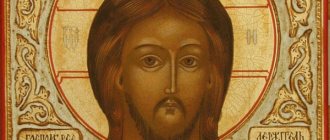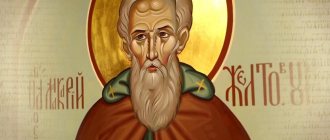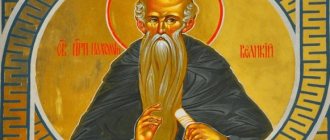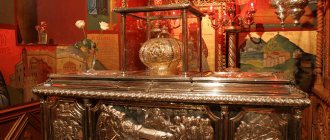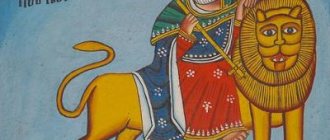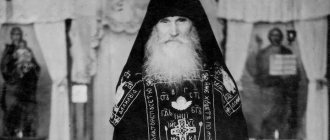Nikita of Constantinople
(c. 761 - c. 838), confessor, venerable
Memory October 13
Born in Paphlagonia around 761 [1]. His parents - probably named Gregory and Anna - gave him a good education. As a child, he was castrated so that he could become an imperial courtier and make a career in public service, because... this opportunity was given to eunuchs.
In 778, at the age of 17, he came to Constantinople and, being a relative of the future holy empress Irene, entered her service. During the reign of Saint Irene and her son Constantine, he was at their court. Thanks to his abilities, he quickly rose through the ranks. In 787, in an unknown capacity, he took part in the affairs of the VII Ecumenical Council. He was then appointed patrician, then prefect, and finally strategos of Sicily, where he succeeded as the defender of that island.
In 802, a palace coup took place that brought Nikephoros I to power, in connection with which the patrician Nikita returned to Constantinople and expressed a desire to leave worldly life and take monasticism. However, the new emperor did not allow him to leave his post in the state administration. In the spring of 807, Nikita was sent by the emperor to command the fleet in Dalmatia, in operations against the Venetians.
Towards the end of 811, after the assassination of Emperor Nikephoros, he was tonsured a monk in the Constantinople Monastery of the Mother of God Chrysonica near the Golden Gate. The tonsure was performed with the consent of Emperor Michael I Rangava, but on the condition that Nikita did not leave Constantinople.
In 815, with the beginning of the second period of iconoclasm, the iconoclast emperor Leo forced Nikita to take refuge in a rural monastery. When the iconoclast Theophilus took the imperial throne, the Monk Nikitas, for denouncing heresy in 830, was expelled from this monastery by heretics and wandered for a long time throughout Bithynia, visiting Erivolon south of Nicomedia, Pantikh, Rufiniana and, finally, the Katavol region southwest of Kios. . But from there he had to leave in order to avoid meeting with Emperor Theophilus, who had set out on a military campaign against the Arabs.
Finally, in 833, he found refuge in his native Paphlogonia, among the peasants of Katisia, where he founded a monastery in honor of the Archangel Michael. Here he ended his days.
He died at the age of 75, around 838 [2]. During his life and after his death, the monk performed many miracles.
Brief biography of Saint Nikita
The Gothic Great Martyr Nikita was born in an area near the Danube and suffered for Jesus in 372. At that time, Christianity was spread throughout the territory of the Goths. Saint Nikita accepted the faith and was baptized by Bishop Theophilus, who was a member of the first Ecumenical Council.
Due to the active spread of Orthodoxy, pagan Goths appeared who opposed this faith, which led to frequent wars and clashes. When, as a result of one of the bloody wars, the leader of the Christian army, Fritigern, expelled the pagan Athanaric, the spread of faith among the Goths continued.
Nikita Gotfsky, Constantinople made every effort to develop Christianity among his people. By setting his own example and inspiring people, he led a large number of pagans who had previously rejected Christianity to accept the faith. At the same time, Bishop Ulfila developed a special alphabet, where he translated religious scriptures into the native language of the tribe.
After a certain period after the victory over Athanaric, the pagan was able to restore his resources, return to the lands of the Goths and regain his early power. His views remained unshakable - he did not accept the Christian faith and persecuted all its followers. During the next civil strife, adherents of Athanarikh’s views seized the saint and subjected him to numerous tortures. After this, the great martyr was thrown into the fire. The next night, Nikita's close friend, Orthodox Marian, found the dead body of the great martyr, miraculously remaining intact after the fire and illuminated by light, took it out and buried it in Cilicia. Subsequently, the body was transferred and buried on the territory of Constantinople. Part of the sacred relics of the martyr was given to the Serbian monastery of Vysoki Decani.
Memorial Day of St. Nikita the Confessor
His mother died on the 8th day after his birth, and his father, named Philaret, became a monk.
The child remained in the care of his grandmother, who raised him in a true Christian spirit. From his youth, Saint Nikita served in the church and was in obedience to the hermit Stephen. With his blessing, Saint Nikita went to the Midice monastery, where Saint Nikephoros was the abbot.
After seven years of virtuous life in a monastery famous for the strictness of its rules, the Monk Nikita was ordained a presbyter. The Monk Nicephorus, knowing the holy life of the young monk, entrusted him with the management of the monastery, since he himself was seriously ill.
Sparing no effort, the Monk Nikita began to take care of the prosperity and improvement of the monastery. He taught the brethren by his personal example of strict monastic life. Soon the fame of the high life of the inhabitants of the monastery attracted many people there seeking salvation. A few years later the number of monks increased to 100 people.
When the Monk Nicephorus departed to the Lord in old age, the brethren unanimously elected the Monk Nikita as abbot.
The Lord honored Saint Nikita with the gift of miracles. Through his prayer, the deaf-mute youth regained the gift of speech; two demon-possessed women were healed; those deprived of reason were restored to reason, and many other sick people were healed of their ailments.
In those years, under Emperor Leo the Armenian (813 - 820), the iconoclastic heresy resumed and the persecution of holy icons intensified. Orthodox bishops were expelled and exiled. In Constantinople in 815, a council of heretics was convened, at which they overthrew the holy Patriarch Nicephorus from the throne, and in his place they elected a heretic from the laity, Theodotus. Heretics were also installed in place of the exiled and imprisoned Orthodox bishops. The emperor summoned the abbots of all the monasteries and tried to attract them to the iconoclastic heresy. Among those called was the Monk Nikita, who firmly stood for the Orthodox confession. Following his example, all abbots remained faithful to the veneration of holy icons. For this they were put in prison. The Monk Nikita bravely endured all the trials and supported the strength of spirit in other prisoners.
Then the emperor and the false patriarch Theodotus decided to use cunning to catch the stubborn ones. They were told that the emperor would grant everyone freedom and allow the worship of icons on one condition: if they accepted Communion from the false patriarch Theodotus. The monk doubted for a long time whether he could enter into church communion with the heretic, but other prisoners begged him to take communion with them. Yielding to their pleas, the Monk Nikita went to the temple, where icons were displayed to deceive confessors, and received Communion. But when he returned to his monastery and saw that the persecution of icons was continuing, he repented of his action, returned to Constantinople and began to fearlessly denounce the iconoclastic heresy. All the emperor's entreaties were rejected by him. The Monk Nikita was again imprisoned, where he remained for six years, until the death of Emperor Leo the Armenian. There, enduring hunger and sorrow, the Monk Nikita performed miracles with the power of his prayers: through his prayer, the Phrygian king released two captives without ransom; three shipwrecked people for whom the Monk Nikita prayed were thrown ashore by the waves. In 824, under the new emperor Michael (820 - 829), the Monk Nikita departed to the Lord. The body of the saint was buried with honors in the monastery. Subsequently, his relics became a source of healing for those who came to venerate the holy confessor.
You can applaud the author (at least 10 times)5
Meaning in Orthodoxy
The role of Saint Nikita has always been appreciated in the Orthodox world. Despite the constant internecine wars with the pagans, he did not betray his faith and introduced his fellow tribesmen to it. In the modern world, the figure of the martyr remains significant, and a large number of temples have been built in his honor, including the following temples of the Great Martyr. Nikita:
- Church of the Epiphany Deanery, located in the Basmanny district of Moscow;
- the temple across the Yauza River on Shvivaya Hill;
- Voronezh Church of Nikita Gotfsky.
Memorial Days
The official day of remembrance of the Great Martyr Nikita is September 28. According to the old calendar, Memorial Day falls on the 15th. Orthodox people name and baptize a large number of children in honor of the saint, and the courageous feat of the great martyr is recorded in the book of Lives of the Saints. The acts of Saint Nikita, as well as Bishop Theophilos, together with his follower Wulfil, are described in a number of historical documents.
Literature
- Ed. “Lives”: Papachryssanthou D., “Un confesseur du second Iconoclasme: la vie du patrice Nicétas (836),” TM
, 3 (1968), 309-51.
- Acta Sanctorum
, October, vol. 3. - Butler, 6.10.
- BHG
, 1342b-1342e. - Janin R., Bibl Sanct
, 9 (1967) 892f. - Guilland, Titres
, X:597. - Janin, ÉglisesCP
, 541 - Treadgold, Byz.
Revival , 144, 147, 169, 403.
Lyrics
During his life, Saint Nikita deeply studied the foundations of the Orthodox faith, and several religious texts are associated with his name. They are designated in the scriptures and are known to everyone who has immersed themselves in church history.
Troparion
In the Orthodox Church, a troparion is a short chant intended to praise and call for help from a sacred image. Troparion to Nikita the Great Martyr is as follows: “Thy martyr, Lord, Nikita/ in his suffering received an imperishable crown from You, our God:/ having Thy strength,/ overthrow the tormentors,/ crush the demons of weak insolence./ With his prayers// save our souls "
Kontakion
The term kontakion originally referred to parchment scrolls containing records of church chants. Then the word kontakion began to mean a short church song intended to praise God, the Mother of God or a saint. The song to Nikita of Goth and Constantinople contains the following words:
“You have cut off the power of delights by your standing / and we will receive the crown of victory in your suffering, / with the Angels, more glorious, rejoicing, / Nikita’s namesake, / / with them, praying to Christ God incessantly for all of us.”
Prayer
The prayer to the Holy Great Martyr Nikita contains forgiveness for gifts for soul and body. When addressing the holy image, the following text is pronounced:
“Oh, the great passion-bearer of Christ, Nikito! Hear the prayer of us sinners, and deliver us (names) from all sorrow and adversity, from sudden death and from all evil: at the hour of separation of the soul from the body, passion-bearing, every evil thought and evil demons, so that our souls may be received in peace to the place of light, Christ the Lord our God, for from Him is the cleansing of sins, and He is the salvation of our souls, to Him belongs all glory, honor and worship, with the Father and the Holy Spirit, now and ever and unto ages of ages. Amen".
Iconography
In Orthodoxy there are two most famous saints named Nikita: Besogon and the martyr of Goth. Their names, memorial dates and deeds performed in the name of the Lord God are strongly intertwined, which leads to difficulties in studying the icon.
It is not always possible to accurately understand who is actually depicted on the icon, so you should understand the nuances of iconography.
The icons of the great martyr have a number of common details with the images of Nikita Besogon, the son of Tsar Maximian, who suffered for his faith in Constantinople. Similarities on the icons include text inscriptions, general type, armor, weapons, and a scarlet cloak. All of the above coincidences often lead to confusion, especially for those people who do not understand the nuances of iconography.
In religious matters you need to be careful and extremely attentive, so before visiting the Nikitsky monastery or temple, it is better to find out in advance in whose honor it is consecrated. There is a possibility that it was consecrated in the name of Nikita the Stylite or the Confessor.
On icons depicting Gotfsky there is always the inscription Saint Nikita the warrior or the Holy Great Martyr Nikita, warrior of Christ. The commander is drawn on a bluish or gilded background. Some icons depict the moment of the battle with the pagans on the battlefield.
The most problematic place in iconography is contracture, which is translated from Latin as tightening. When studying an icon, it is important to correctly read the abbreviation, which can be written in Church Slavonic, Old Russian, Serbian or Greek. Insufficient knowledge sometimes does not provide a complete picture or does not provide any understanding of the inscription on the icon. The inscriptions on the images depicting the martyr, in contrast to well-known abbreviations, have a superscript abbreviation element - a title, which is located above the contractures.
You can recognize Saint Nikita in the images by individual elements, including clothing and weapons. Since in iconography the great martyr is depicted primarily as a warrior, he is always dressed in armor. Also, the leader of the troops is entitled to a cloak called a red sagun, which is a kind of symbol of the commander and military leader. Saint Nikita's weapons are depicted as a painful spear, a bow with arrows, a blade or a shield. Even if one of the hands holds a cross, the other always holds a military weapon.
Life
Saint Nikita was born in Paphlagonia from pious parents. He was a distant relative of Empress Theodora, wife of the iconoclast Emperor Theophilus. After training, at the age of 17, Nikita came to Constantinople. At that time, the imperial throne was occupied by the wife of the deceased Emperor Leo IV, Irina, due to the early childhood of her son Constantine. Accepted into the royal service, Nikita soon rose to the occasion, was elevated to patrician dignity and made caretaker of the entire royal palace, and then made commander of the troops in Sicily. Having reached a high position, Nikita realized all the futility and vanity of worldly titles and blessings and had a pious desire to take monastic vows. But Emperor Nikifor and his son Stavraki, appreciating Nikita’s services to the state, did not want to dismiss him from his position and let him go to a monastery. When, after them, Mikhail Rangav ascended the kingdom, Nikita asked him for permission to leave his service and take monastic vows. However, he was not allowed to leave the capital, but the emperor ordered him to be given quarters in the Golden Gate, in the so-called Chrysonicia, where he was to remain permanently. In this monastery Saint Nikita remained hopelessly until the reign of the iconoclast emperor Leo the Armenian. When Saint Nikita saw the desecration to which the holy icons were subjected to by this lawless king, he left Constantinople and joined the lower brethren of a suburban monastery and there spent time in fasting and labor. Meanwhile, the iconoclasts, having discovered that he had an icon of the Savior, which he acquired from Rome, reported this to the emperor. Officials were sent to Nikita, who with threats forced him to hand over this icon. But since Saint Nikita resolutely refused to hand her over, the messengers found one monk who pointed out where that holy icon was located. Then they entered the church and, taking the holy icon, abused it in every possible way. This blasphemy led Saint Nikita into great sorrow. Not content with this, the royal envoys, leaving the monastery, forbade him to leave there under any pretext. Subsequently, when another iconoclastic sovereign, Theophilus, ascended the royal throne, one courtier named Theodosius was sent to the monk, who, in front of all those gathered, under the threat of expulsion, demanded from him recognition of the iconoclastic Patriarch Anthony and the rejection of icon veneration. But the saint said to this:
I will never stop worshiping the icon of Christ and my God, and I will call Anthony not a patriarch, but an adulterer and a criminal... You do what you want.
For this courageous feat of faith, Saint Nikita was immediately expelled from the monastery. Having given thanks to God and taking with him three of the brethren, he went to another monastery, where he spent Great Lent and the time until Pentecost, and then left this monastery. After many wanderings and hardships, he finally settled in a seaside monastery, where he ended his life at the age of 76. Both during his life and after his death, he performed many miracles.

